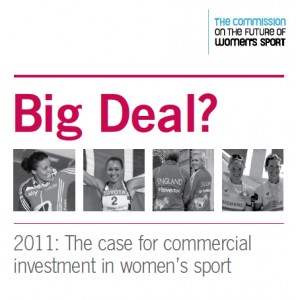De ‘Commission on the Future of Women’s Sports’ had wel verwacht dat er in de Britse vrouwensport minder sponsorgeld omging dan in traditionele mannensporten. Maar de conclusies van een onderzoek, waaruit bleek dat vrouwensport slechts een half procent van de totale sponsormarkt beslaat, was voor hen absoluut opzienbarend. Toch liggen er volop commerciële kansen.

Agnes Elling van het Mulierinstituut (sportonderzoek) verwacht dat de verhoudingen ook in Nederland wel redelijk vergelijkbaar zijn: “Dat heeft voor een groot deel te maken met de dominantie van voetbal in de sponsoruitgaven. Wij hebben daar geen concrete cijfers over. Uit onderzoek van E-Quality, een paar jaar geleden, bleek dat ook de overheidssubsidies niet evenredig bij mannen en vrouwen terecht komt.”
Mannensporten
In het Britse onderzoek ging 61,1% van de budgetten naar mannensporten en 38,2% naar gemengde sport(evenementen). In het rapport ‘Big Deal’ dat naar aanleiding van het onderzoek is gepubliceerd staan niet alleen de harde conclusies; er worden ook kansen omschreven voor sponsors om met vrouwensport een grote doelgroep te bereiken.
10 redenen om te investeren (overgenomen uit rapport Big Deal)
1. International success
With a roll too long to call, the UK’s elite, international women’s teams and competitors are regularly taking on and beating the rest of the world, often out-performing their male counterparts.
2. Low cost-of-entry
Women’s sport represents exceptionally good value for sponsors’ money. As a market with low levels of investment, sponsors have a prime opportunity, particularly in a difficult economic climate, to acquire not just individual properties at highly competitive prices, but entire sports with valuable audiences, fans and participants. Investec’s sponsorship of England Hockey is a prime example.
3. Large television audiences
The leading women’s events are watched on television by large audiences, many of which rival men’s. Recent examples include the Women’s Wimbledon Final, the FIFA World Cup, the Women’s Open Golf and the Women’s FA Cup Final.
4. Valuable audience profile
The majority of television viewers of women’s sport are men aged between 24 to 35 – male sports fans – one of the most valuable and attractive consumer audiences for sponsors and advertisers; a major opportunity for rightsholders and broadcasters.
5. Positive perceptions
Sports fans hold women’s sport in high regard: it’s considered to be as skilful, exciting and internationally successful as men’s and with a brighter future. These values are attractive to sponsors.
6. Strong demand
There is strong demand for women’s sport from the valuable audience of male sports fans: 61% want to see more women’s sport on television, of which broadcasters should make the most.
7. Uncluttered market
Low levels of investment in an overlooked market mean that women’s sport is uncluttered with sponsors’ brands compared to men’s, offering greater opportunity for brand stand-out and recognition.
8. Unique dual differentiation
Elite women’s sport offers its sponsors a unique dual differentiation: distinctive commercial marketing using sport and sportswomen in different ways to sportsmen (appealing to both male and female consumers and brands) as well as the Corporate Responsibility benefits of investing in a globally successful, developing product with important social benefits.
9. Social media: engagement and profile
Commentators all agree that social media represent an exceptional commercial opportunity for women’s sport; they create direct relationships with audiences that offer value to sponsors and provide both an alternative channel to traditional media and also a means of influencing and utilising traditional media’s broader reach.
10. London 2012: the chance of a lifetime
The overwhelming, positive public attitudes to the Olympics and Paralympics – the global showcase for women’s sport – and their location in London highlight the opportunity for aspiring British medallists and sponsors.
Bron: www.wssf.org.uk